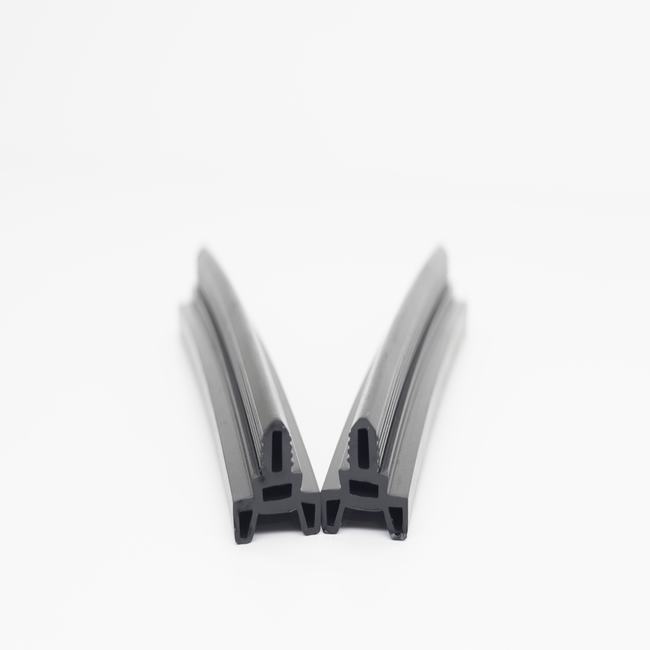Garage door seals are also known as weatherstripping and astragal. Seals are found around all four edges of the garage door. The purpose of a weather seal is to keep insects and critters out of the garage while also keeping moisture and cold air from seeping through the cracks around the garage door. By weatherproofing your garage door, you can save on your energy bill and stay warmer through the winter.
On the sides and top of the garage door, PVC Stop Molding is installed to the wood trim. When the garage door is closed, the sections of the door are intended to be flush against the frame of the garage. This is not, however, usually the case. When you install PVC Stop Molding, the flap of this type of seal will press against the outside of the garage door, closing the gap between the door and the garage frame. Another type of seal is a Reverse Angle Jamb Seal. The clip portion of this seal attaches to a piece of angle iron. Then, the flap, like the PVC Stop Molding, closes the gap between the garage door and the garage frame. There are also some types of seals for the top of the garage door that install to the top of the top section. When the garage door closes, the Flap Top Seal closes against the garage frame.
There are also various Garage Door Seal Retainers that you can install around the sides and top of your garage door. You can then slide Vinyl Seal, Rubber Seal, or Brush Seal into the garage door seal retainers. The advantage of using the retainer and the inserts rather than the one-piece weather seals is that changing your seal insert is a lot easier than changing the entire seal.
The bottom of the garage door also has multiple types of seals. Bottom Astragal is nailed into the bottom of the garage door to make a tight fit with the garage floor. Other bottom seals are a little more intricate like the Twin Contact Bottom Seal.
Bottom Seal Retainers on a garage door serve the same purpose. Like the top and side retainers, the bottom retainers come in various shapes and dimensions. Depending on the shape of the slots in the bottom retainers, you can slide inserts (vinyl or rubber) with T-Shaped or Bead-Shaped ends onto the retainer.
Garage door seals, also known as garage door weatherstripping or garage door gaskets, are essential components of garage doors that provide a seal between the door and the garage opening. These seals help prevent the entry of unwanted elements such as rain, dust, drafts, pests, and even noise into the garage, making them an important part of maintaining the garage’s cleanliness, energy efficiency, and security. Here’s an overview of garage door seals:
Types of Garage Door Seals:
- Bottom Seals: These seals are typically attached to the bottom of the garage door and create a tight seal with the garage floor. They come in various materials, including rubber, vinyl, or brush-like materials. Bottom seals also help prevent water from entering the garage during heavy rain.
- Side Seals: Side seals are installed on the sides of the garage door to prevent drafts and weather from entering through the gaps between the door and the door frame. They can be made from flexible materials that conform to the contours of the door and frame.
- Top Seals: Top seals, also known as header seals, are placed at the top of the garage door to seal the gap between the top of the door and the garage header. They are especially useful in preventing drafts and weather from entering the garage.
- Threshold Seals: Threshold seals are installed directly on the garage floor at the entrance. They create a barrier against water, leaves, and pests, preventing them from infiltrating the garage.
Materials:
Garage door seals are available in various materials to suit different needs and preferences:
- Rubber: Rubber seals are durable and flexible, making them effective at sealing gaps and resisting weather exposure.
- Vinyl: Vinyl seals are affordable and easy to install. They offer decent weather resistance and durability.
- Brush or Bristle Seals: These seals consist of densely packed brush-like bristles, often made of nylon or other synthetic materials. They provide an effective barrier against drafts and pests while allowing easy movement of the garage door.
- Metal or Aluminum: Some threshold seals have aluminum or metal components, offering additional durability and protection.
Installation and Maintenance:
Proper installation of garage door seals is essential to ensure their effectiveness. This may involve measuring and cutting the seals to fit the door properly and attaching them securely to the door and surrounding frame.
Maintenance typically includes periodic inspection of the seals for wear and tear, especially at the bottom where they may come into contact with the ground. Damaged or worn seals should be replaced promptly to maintain the seal’s integrity.
In summary, garage door seals are important for maintaining the cleanliness, energy efficiency, and security of your garage. They come in various types and materials to suit different needs, and proper installation and maintenance are key to their effectiveness. Replacing worn or damaged seals can help ensure your garage remains protected from the elements and pests.


